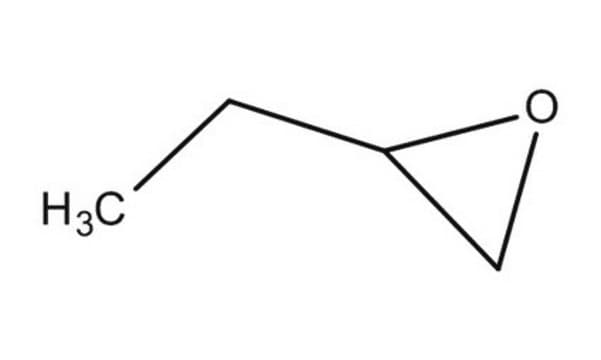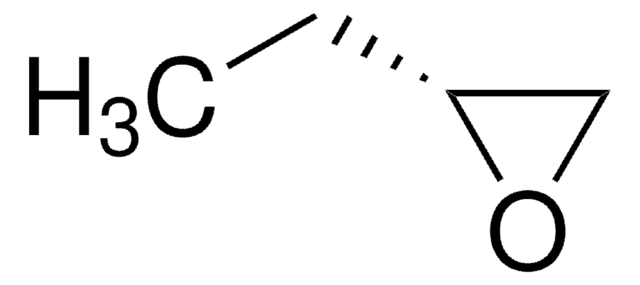109975
1-Butenoxid
99%
Synonym(e):
α-Butylenoxid, 1,2-Epoxy-butan, 1,2-Epoxybutan, Ethyloxiran
About This Item
Empfohlene Produkte
Dampfdichte
2.2 (vs air)
Dampfdruck
140 mmHg ( 20 °C)
Assay
99%
Selbstzündungstemp.
698 °F
Expl.-Gr.
19 %
Brechungsindex
n20/D 1.384 (lit.)
bp
63 °C (lit.)
Dichte
0.829 g/mL at 25 °C (lit.)
SMILES String
CCC1CO1
InChI
1S/C4H8O/c1-2-4-3-5-4/h4H,2-3H2,1H3
InChIKey
RBACIKXCRWGCBB-UHFFFAOYSA-N
Suchen Sie nach ähnlichen Produkten? Aufrufen Leitfaden zum Produktvergleich
Verwandte Kategorien
Anwendung
- As a monomer to synthesize novel initiators via ring-opening polymerization. These initiators can be used to prepare complex macromolecules such as grafted polyamides.
- To functionalize polyethyleneimine which is used in the synthesis of oxidation-stable adsorbents for CO2 capture.
Leistungsmerkmale und Vorteile
- High polymerizability
- Low susceptibility to transfer reaction
- Ease of handling
Signalwort
Danger
Gefahreneinstufungen
Acute Tox. 4 Dermal - Acute Tox. 4 Inhalation - Acute Tox. 4 Oral - Carc. 2 - Eye Irrit. 2 - Flam. Liq. 2 - Skin Irrit. 2 - STOT SE 3
Zielorgane
Respiratory system
Lagerklassenschlüssel
3 - Flammable liquids
WGK
WGK 1
Flammpunkt (°F)
5.0 °F - closed cup
Flammpunkt (°C)
-15 °C - closed cup
Persönliche Schutzausrüstung
Eyeshields, Faceshields, Gloves
Analysenzertifikate (COA)
Suchen Sie nach Analysenzertifikate (COA), indem Sie die Lot-/Chargennummer des Produkts eingeben. Lot- und Chargennummern sind auf dem Produktetikett hinter den Wörtern ‘Lot’ oder ‘Batch’ (Lot oder Charge) zu finden.
Besitzen Sie dieses Produkt bereits?
In der Dokumentenbibliothek finden Sie die Dokumentation zu den Produkten, die Sie kürzlich erworben haben.
Kunden haben sich ebenfalls angesehen
Unser Team von Wissenschaftlern verfügt über Erfahrung in allen Forschungsbereichen einschließlich Life Science, Materialwissenschaften, chemischer Synthese, Chromatographie, Analytik und vielen mehr..
Setzen Sie sich mit dem technischen Dienst in Verbindung.














